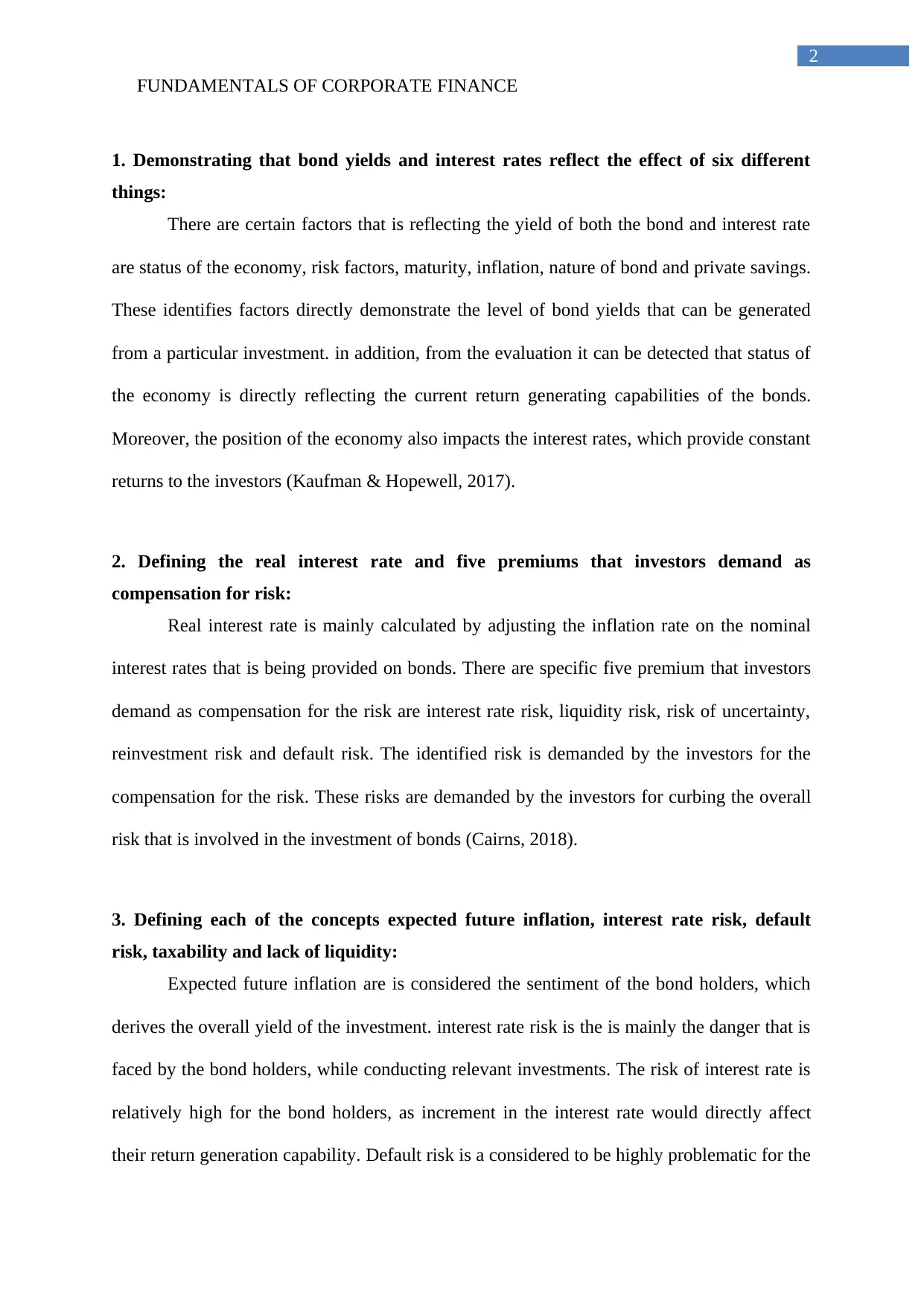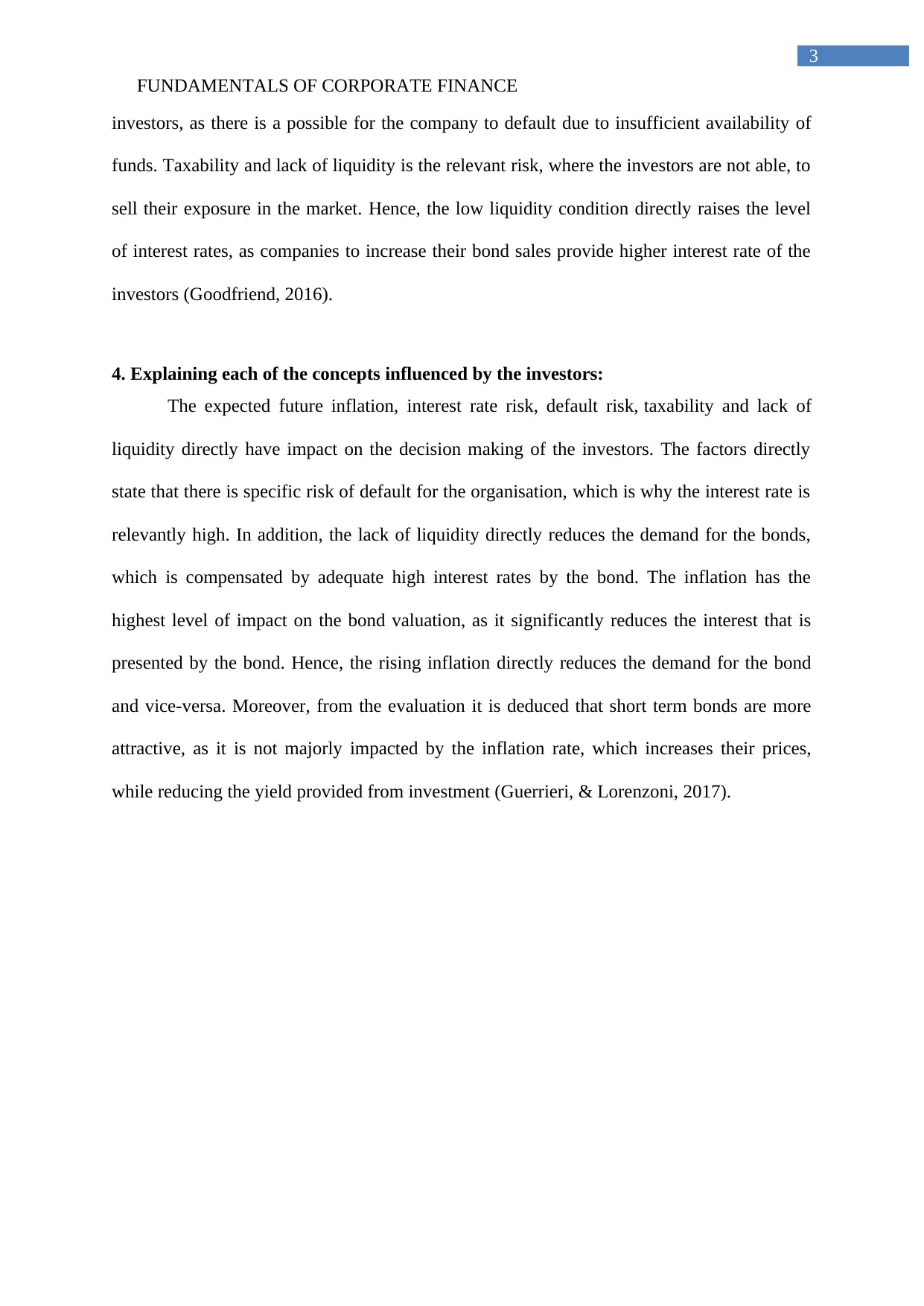Analysis of Bond Yields and Interest Rates - Corporate Finance Study
VerifiedAdded on 2023/04/22
|5
|879
|359
Report
AI Summary
This report delves into the fundamentals of corporate finance, examining the factors influencing bond yields and interest rates. It identifies six elements affecting bond yields, including economic status, risk factors, maturity, inflation, bond nature, and private savings. The report defines the real interest rate and outlines five risk premiums demanded by investors: interest rate risk, liquidity risk, uncertainty risk, reinvestment risk, and default risk. It also explains concepts like expected future inflation, interest rate risk, default risk, taxability, and lack of liquidity, highlighting their impact on investment decisions. The analysis underscores how these factors, particularly inflation and liquidity, shape investor behavior and bond valuation, noting the attractiveness of short-term bonds due to their lower sensitivity to inflation. Desklib provides access to similar solved assignments and study tools for students.

Running head: FUNDAMENTALS OF CORPORATE FINANCE
Fundamentals of corporate finance
Name of the Student:
Name of the University:
Authors Note:
Fundamentals of corporate finance
Name of the Student:
Name of the University:
Authors Note:
Paraphrase This Document
Need a fresh take? Get an instant paraphrase of this document with our AI Paraphraser

FUNDAMENTALS OF CORPORATE FINANCE
1
Table of Contents
1. Demonstrating that bond yields and interest rates reflect the effect of six different things:. 2
2. Defining the real interest rate and five premiums that investors demand as compensation
for risk:.......................................................................................................................................2
3. Defining each of the concepts expected future inflation, interest rate risk, default
risk, taxability and lack of liquidity:..........................................................................................2
4. Explaining each of the concepts influenced by the investors:...............................................3
References:.................................................................................................................................4
1
Table of Contents
1. Demonstrating that bond yields and interest rates reflect the effect of six different things:. 2
2. Defining the real interest rate and five premiums that investors demand as compensation
for risk:.......................................................................................................................................2
3. Defining each of the concepts expected future inflation, interest rate risk, default
risk, taxability and lack of liquidity:..........................................................................................2
4. Explaining each of the concepts influenced by the investors:...............................................3
References:.................................................................................................................................4

FUNDAMENTALS OF CORPORATE FINANCE
2
1. Demonstrating that bond yields and interest rates reflect the effect of six different
things:
There are certain factors that is reflecting the yield of both the bond and interest rate
are status of the economy, risk factors, maturity, inflation, nature of bond and private savings.
These identifies factors directly demonstrate the level of bond yields that can be generated
from a particular investment. in addition, from the evaluation it can be detected that status of
the economy is directly reflecting the current return generating capabilities of the bonds.
Moreover, the position of the economy also impacts the interest rates, which provide constant
returns to the investors (Kaufman & Hopewell, 2017).
2. Defining the real interest rate and five premiums that investors demand as
compensation for risk:
Real interest rate is mainly calculated by adjusting the inflation rate on the nominal
interest rates that is being provided on bonds. There are specific five premium that investors
demand as compensation for the risk are interest rate risk, liquidity risk, risk of uncertainty,
reinvestment risk and default risk. The identified risk is demanded by the investors for the
compensation for the risk. These risks are demanded by the investors for curbing the overall
risk that is involved in the investment of bonds (Cairns, 2018).
3. Defining each of the concepts expected future inflation, interest rate risk, default
risk, taxability and lack of liquidity:
Expected future inflation are is considered the sentiment of the bond holders, which
derives the overall yield of the investment. interest rate risk is the is mainly the danger that is
faced by the bond holders, while conducting relevant investments. The risk of interest rate is
relatively high for the bond holders, as increment in the interest rate would directly affect
their return generation capability. Default risk is a considered to be highly problematic for the
2
1. Demonstrating that bond yields and interest rates reflect the effect of six different
things:
There are certain factors that is reflecting the yield of both the bond and interest rate
are status of the economy, risk factors, maturity, inflation, nature of bond and private savings.
These identifies factors directly demonstrate the level of bond yields that can be generated
from a particular investment. in addition, from the evaluation it can be detected that status of
the economy is directly reflecting the current return generating capabilities of the bonds.
Moreover, the position of the economy also impacts the interest rates, which provide constant
returns to the investors (Kaufman & Hopewell, 2017).
2. Defining the real interest rate and five premiums that investors demand as
compensation for risk:
Real interest rate is mainly calculated by adjusting the inflation rate on the nominal
interest rates that is being provided on bonds. There are specific five premium that investors
demand as compensation for the risk are interest rate risk, liquidity risk, risk of uncertainty,
reinvestment risk and default risk. The identified risk is demanded by the investors for the
compensation for the risk. These risks are demanded by the investors for curbing the overall
risk that is involved in the investment of bonds (Cairns, 2018).
3. Defining each of the concepts expected future inflation, interest rate risk, default
risk, taxability and lack of liquidity:
Expected future inflation are is considered the sentiment of the bond holders, which
derives the overall yield of the investment. interest rate risk is the is mainly the danger that is
faced by the bond holders, while conducting relevant investments. The risk of interest rate is
relatively high for the bond holders, as increment in the interest rate would directly affect
their return generation capability. Default risk is a considered to be highly problematic for the
⊘ This is a preview!⊘
Do you want full access?
Subscribe today to unlock all pages.

Trusted by 1+ million students worldwide

FUNDAMENTALS OF CORPORATE FINANCE
3
investors, as there is a possible for the company to default due to insufficient availability of
funds. Taxability and lack of liquidity is the relevant risk, where the investors are not able, to
sell their exposure in the market. Hence, the low liquidity condition directly raises the level
of interest rates, as companies to increase their bond sales provide higher interest rate of the
investors (Goodfriend, 2016).
4. Explaining each of the concepts influenced by the investors:
The expected future inflation, interest rate risk, default risk, taxability and lack of
liquidity directly have impact on the decision making of the investors. The factors directly
state that there is specific risk of default for the organisation, which is why the interest rate is
relevantly high. In addition, the lack of liquidity directly reduces the demand for the bonds,
which is compensated by adequate high interest rates by the bond. The inflation has the
highest level of impact on the bond valuation, as it significantly reduces the interest that is
presented by the bond. Hence, the rising inflation directly reduces the demand for the bond
and vice-versa. Moreover, from the evaluation it is deduced that short term bonds are more
attractive, as it is not majorly impacted by the inflation rate, which increases their prices,
while reducing the yield provided from investment (Guerrieri, & Lorenzoni, 2017).
3
investors, as there is a possible for the company to default due to insufficient availability of
funds. Taxability and lack of liquidity is the relevant risk, where the investors are not able, to
sell their exposure in the market. Hence, the low liquidity condition directly raises the level
of interest rates, as companies to increase their bond sales provide higher interest rate of the
investors (Goodfriend, 2016).
4. Explaining each of the concepts influenced by the investors:
The expected future inflation, interest rate risk, default risk, taxability and lack of
liquidity directly have impact on the decision making of the investors. The factors directly
state that there is specific risk of default for the organisation, which is why the interest rate is
relevantly high. In addition, the lack of liquidity directly reduces the demand for the bonds,
which is compensated by adequate high interest rates by the bond. The inflation has the
highest level of impact on the bond valuation, as it significantly reduces the interest that is
presented by the bond. Hence, the rising inflation directly reduces the demand for the bond
and vice-versa. Moreover, from the evaluation it is deduced that short term bonds are more
attractive, as it is not majorly impacted by the inflation rate, which increases their prices,
while reducing the yield provided from investment (Guerrieri, & Lorenzoni, 2017).
Paraphrase This Document
Need a fresh take? Get an instant paraphrase of this document with our AI Paraphraser

FUNDAMENTALS OF CORPORATE FINANCE
4
References:
Cairns, A. J. (2018). Interest rate models: an introduction. Princeton University Press.
Goodfriend, M. (2016, August). The case for unencumbering interest rate policy at the zero
bound. In Federal Reserve Bank of Kansas City’s 40th Economic Policy Symposium.
Jackson Hole, WY. August (Vol. 26).
Guerrieri, V., & Lorenzoni, G. (2017). Credit crises, precautionary savings, and the liquidity
trap. The Quarterly Journal of Economics, 132(3), 1427-1467.
Kaufman, G. G., & Hopewell, M. H. (2017). Bond price volatility and term to maturity: A
generalized respecification. In Bond Duration and Immunization (pp. 64-68).
Routledge.
4
References:
Cairns, A. J. (2018). Interest rate models: an introduction. Princeton University Press.
Goodfriend, M. (2016, August). The case for unencumbering interest rate policy at the zero
bound. In Federal Reserve Bank of Kansas City’s 40th Economic Policy Symposium.
Jackson Hole, WY. August (Vol. 26).
Guerrieri, V., & Lorenzoni, G. (2017). Credit crises, precautionary savings, and the liquidity
trap. The Quarterly Journal of Economics, 132(3), 1427-1467.
Kaufman, G. G., & Hopewell, M. H. (2017). Bond price volatility and term to maturity: A
generalized respecification. In Bond Duration and Immunization (pp. 64-68).
Routledge.
1 out of 5
Related Documents
Your All-in-One AI-Powered Toolkit for Academic Success.
+13062052269
info@desklib.com
Available 24*7 on WhatsApp / Email
![[object Object]](/_next/static/media/star-bottom.7253800d.svg)
Unlock your academic potential
Copyright © 2020–2025 A2Z Services. All Rights Reserved. Developed and managed by ZUCOL.





